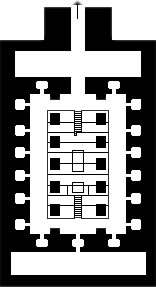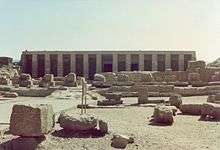Osireion
The Osirion or Osireon is an ancient Egyptian temple. It is located at Abydos, to the rear of the temple of Seti I. It is an integral part of Seti I's funeral complex and is built to resemble an 18th Dynasty Valley of the Kings tomb.[1] It was discovered by archaeologists Flinders Petrie and Margaret Murray who were excavating the site in 1902-3. The Osirion was originally built at a considerably lower level than the foundations of the temple of Seti, who ruled from 1294 - 1279 BC.[2] While there is disagreement as to its true age, Peter Brand says it "can be dated confidently to Seti's reign",[3] despite the fact that it is situated at a lower depth than the structures nearby, that it features a very different architectural approach, and that it is frequently flooded with water which would have made carving it impossible had the water level been the same at the time of construction.
See also
Notes
- ↑ Bard, Katheryn (1999). Encyclopedia of the Archaeology of Ancient Egypt. Routledge. p. 114. ISBN 0-415-18589-0.
- ↑ Rice, Michael (1999). Who's Who in Ancient Egypt. Routledge.
- ↑ Brand, Peter J. The Monuments of Seti I: Epigraphic, Historical and Art Historical Analysis Brill September 2000, ISBN 978-90-04-11770-9 p. 175

External links
| Wikimedia Commons has media related to Osireion. |
- The Osirion The original notes by archeologist Sir William Flinders-Petrie on the discovery of the Osirion site, published in 1903.
References
- Frankfort, H., De Buck, A. & Gunn, B. The Cenotaph of Seti I at Abydos, 2 vol. Memoir of the Egypt Exploration Society, Egypt Exploration Society. London, 1933.
- Murray, Margaret A. The Osirion at Abydos, British School of Egyptian Archeology n°1, London, 1904.
Coordinates: 26°11′03″N 31°55′06″E / 26.1841°N 31.9184°E
